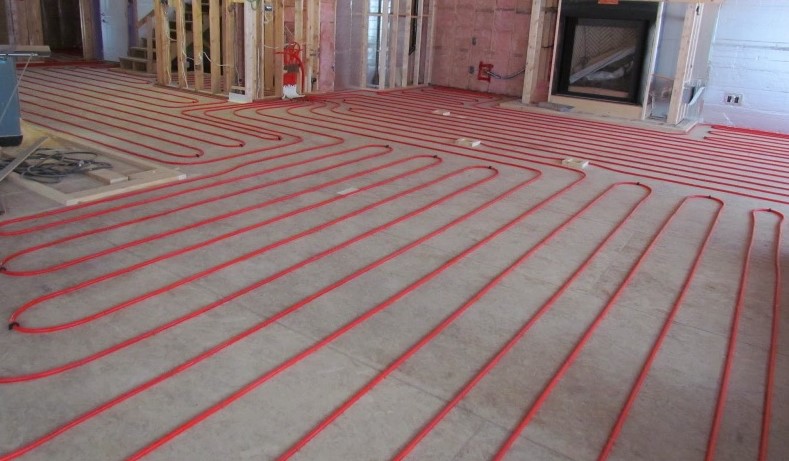Electric radiant floor heating is an increasingly popular home addition – and for good reason. These systems have gotten much cheaper in recent years while offering an unrivaled level of efficiency.
In this electric radiant floor heating review, we’ll dive deeper into what makes these systems so great. We’ll also show you the various types of radiant floor heating on the market.
Electric Radiant Floor Heating Review: The Basics
Electric radiant floor heating systems pass heat directly through, as you can probably guess, the floor. This differs from conventional forced-air heating systems that rely on ducts and registers for delivering heat around a building.
Radiant floor heating systems are advantageous for several reasons. For one, they’re more efficient as they eliminate the heat leakage characteristic of older HVAC systems that have been poorly maintained.
Because air is not being forced through registers, people with allergies also find electric radiant floor heating to be less of an irritant. The heat simply rises – radiates – from the floor upwards, warming the room without spreading allergens.
Types of Radiant Floor Heating
Heated flooring systems come in one of three types – electric, air, and hydronic. Here’s a quick look at what each entails.
Air Radiant Floor Heating
This type of system passes hot air through pipes under your flooring. The hot air then radiates throughout your home. This is the least popular type of radiant flooring in homes because it’s cost-intensive; air doesn’t radiate heat as effectively as water or electricity.
Electric Radiant Floor Heating
Electric radiant floor heating systems rely on conductive wires that, when combined with the right flooring material, can keep your home heated for the entire day.
Because electricity is so expensive, it’s imperative that you have the right flooring material (ideally concrete) when using electric radiant floor heating, for reasons we’ll discuss in a future section.
Hydronic Radiant Floors
With hydronic radiant floors, warm water gets passed from a boiler through a series of plastic tubes under the flooring material. This is by far the most popular radiant flooring method since it’s very cost-effective; water is cheaper than electricity.
Electric Radiant Floor Heating Review: Pros and Cons
Now that you know a little bit about the various types of radiant floor heating, let’s focus on today’s topic of discussion – the electric variety. Specifically, we’ll discuss the pros and cons.
Pro: Easy Installation
Electric radiant floor heating is very easy to install. You can purchase DIY kits consisting of rolled-up devices that go underneath your flooring. Once the unit is connected to electricity, it’s ready for use!
Air or water-based radiant heating systems, on the other hand, are more labor-intensive to install. You’ll need a furnace or boiler to actually pump the medium through the tubes, which can be costly.
Con: Costlier to Operate
While electric radiant floor heating may be cheaper to install, you’ll feel a strain on your wallet when it comes to actually using the system. That’s because electricity costs more than water – even in Missoula, where our electricity rates are actually on the lower side compared to other American cities.
This alone may make electric radiant floor heating far from the best choice for anyone living in a region that experiences harsh winters (like Missoula).
Of course, the increase in your electricity bill will likely be offset by a decrease in your heating bill. However, you could save even more money by using hydronic radiant heated floors instead.
Pro: Silent Operation
While many people grow accustomed to the steady hum of HVAC systems, others find it to be quite annoying. Electric radiant heating systems operate silently, making them the preferred option for these people. Note that water-based systems don’t make much noise either.
Con: Issues May Be Costly to Repair
Electrical wires are not immune to failure, particularly when they’re frequently being subjected to pressure from your feet and heavy objects being rolled around.
When a wire does fail, it may cause the entire system to stop working properly. This can be a major inconvenience if your floor heating system is your home’s primary source of warmth in winter; you’ll need to lift your flooring material up to access and repair the faulty wire.
Pro: Reduced Allergen Spread
Forced-air HVAC systems are notoriously rough on people with allergies. They spread pollutants, allergens, and pathogens with ease. Electric radiant floor heating system reviews often rightly highlight that these systems are much friendlier to those with allergies because they don’t distribute air.
Con: You’ll Need to Replace the Flooring
This isn’t limited to electric radiant floor heating, mind you. To install any type of radiant floor heating, you’ll need to lift the flooring material completely. This is why radiant heat flooring installations are ideally done when you’re constructing a new home.
Electric Radiant Floor Heating Installation Process
Next, let’s take a look at the process of installing radiant floor heating. There are two main options: wet and dry installations.
Wet Radiant Floor Heating Installation
Wet installations involve embedding the heating apparatus into your flooring. This is the oldest strategy for radiant floor heating installation. Many of the first buildings to use this technology had concrete flooring with tubes or wires set within the concrete itself.
The advantage of this is that thicker, more substantial flooring materials retain heat. If you’re relying on solar electricity for your heating mechanism, this allows the floors to stay warm for up to 10 hours even when the sun is not present (i.e. at night).
Less-solid flooring materials would give off the heat too quickly.
Dry Radiant Floor Heating Installation
Dry installations are a fairly newer invention, having been made possible by advancements in radiant floor technology. They entail running pipes or tubing underneath your flooring material or in between sublayers.
While a system installed in this manner needs to operate at higher temperatures, it will be a cheaper setup. Homeowners also enjoy being able to repair their radiant flooring system with greater ease.
Ideal Flooring Materials for Radiant Heat Systems
As mentioned earlier, concrete is arguably best for electric radiant floor heating because it can retain heat even when the source of electricity (i.e. solar power) is offline.
However, ceramic tile is also a very popular choice because it conducts heat well, is cheaper than pouring concrete, and can retain heat adequately.
Other materials like plywood, vinyl, and carpet are compatible with radiant floor heating but people use them less-commonly as they aren’t as effective.
For example, you’d have to use a very thin carpet because something overly thick wouldn’t allow the heat to actually radiate upwards.
About Radiant Wall and Ceiling Panels
No review of electric radiant floor heating systems would be complete without mention of wall and ceiling panels. This equipment behaves much like radiant heat flooring systems except they’re mounted in the upper surfaces of your home.
Of course, these systems would be somewhat disadvantageous in homes with higher-than-normal ceilings. Because heat rises, the lower portions of rooms would remain cool, which wouldn’t be the case if the heat radiated from the flooring.
How to Choose the Best Electric Radiant Floor Heating
Now that you know all about electric radiant floor heating, let’s talk about how you can choose the right system for you.
Ask Yourself Whether an Electric System is Really Right for You
Many people purchase electric radiant floor heating systems without even considering the other two options (hydronic and forced-air). While electric systems certainly have their benefits, you’d be wise to take your time and make a careful decision. Hydronic systems, in particular, might offer greater efficiency and utility.
Carefully Consider the Unit’s Response Time
The phrase “response time” as it relates to radiant heating describes the speed with which the system heats up. Some manufacturers incorporate quick-to-respond aluminum versus sluggish gypsum concrete, which will give you a better overall experience.
Consult the Experts
If you’re new to the idea of radiant floor heating, you should absolutely speak with a professional before making a decision. If you live in Missoula, get in touch with us at Plumb-Tech.
While we sell and install radiant heat flooring units, we also work with other types of units, such as fireplaces, furnaces, gas piping, and more. We’ll help you find the right unit for your needs rather than selling you something unnecessary.
We’ve helped thousands of residents select the right plumbing and heating systems in Missoula over the past 20 years! Get in touch with us here.
Frequently Asked Questions
Electric radiant floor heating is very efficient. There’s no opportunity for warm air to leak out of ductwork, unlike with forced-air systems. The electric wires transmit the heat very effectively.
However, you will spend a decent amount of money on the electricity itself, which is more expensive than water. If that’s a concern, you should consider a hydronic radiant floor heating system.
You certainly can. Hydronic flooring is recommended for this, however, since it costs less and leaves less room for faulty wires or other electrical issues to jeopardize your heating apparatus.
If you take care of your radiant heating flooring system, it can last decades. Longevity is only a concern with cheaper, less-reliable units.
The heat will not transmit very well through the rug. This is also why carpet is generally inadvisable with electric underfloor heating; it absorbs heat too well, preventing it from rising and heating your entire room or house.





